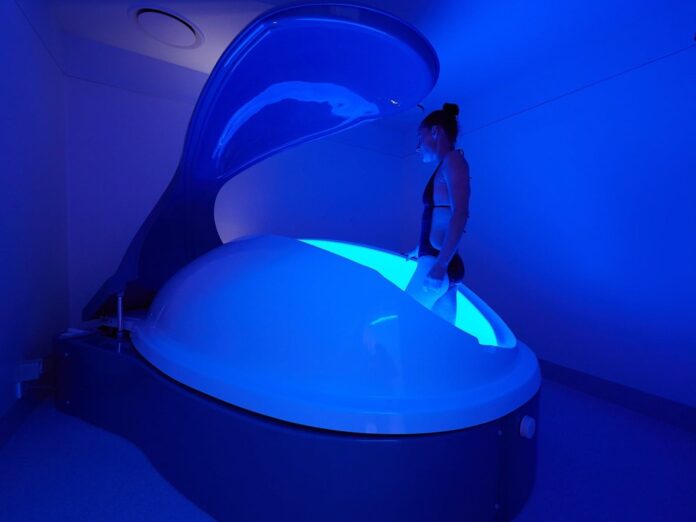What is a floatation tank exactly?
A flotation tank is an enclosed, silent space that contains highly concentrated Epsom salt water that has been heated to body temperature. The technique of relaxing in a floater tank with all sights and sounds blocked out, and drifting into a meditative state that revitalizes your mind and body, is known as flotation, sometimes known as sensory deprivation.
Floatation tanks have many other names
Some of the confusion around floating and flotation tanks are ins some part due to the ever changing ways to describe the pods. Floatation tanks are often also referred to as isolation tanks, sensory deprivation tanks, float tanks, flotation tanks, float pods and in some cases even sensory attenuation tanks (attenuation meaning “any reduction in the strength of a signal”).
The History of floatation tanks
Neuroscientist and psychologist John C. Lilly developed the floating tank for the first time in 1954 in order to study human consciousness.
He conducted sensory deprivation tests to see what would happen to the brain if it were cut off from all external input and senses.
His first tank required him to totally submerge himself in an upright chamber of water while donning a diving mask to block out light and sound.
While in the isolation tank, Lilly experimented with psychedelic drugs and even said he was able to communicate with beings from other dimensions.
In the years that followed, he improved his tank, and by the 1970s, float tanks had begun to resemble the contemporary float tanks we see today.
How do you float in a floatation tank?
Floating is accomplished by putting a lot of Epsom salts in the water. This increases the water’s density and buoyancy, much like it does in the Dead Sea.
Around 1000 liters of water and 550 kg of Epsom salts, which are high in magnesium and sulfate, will be used in float tanks, raising the solution’s specific gravity to about 1.27.
This alteration in density is what gives the water buoyancy and makes it possible for someone using a flotation tank to float.
How long is a floatation tank session?
For first-timers, the average flotation tank session lasts 60 to 90 minutes. As you gain knowledge and expertise, you might discover that 60 or 90 minutes are plenty. Some people might like to float for 2, 3, or even more hours.
People frequently inquire about the duration of float sessions. The quick, succinct response is 60 minutes. Usually, you can choose to extend your float for up to three hours or 90 minutes.
If it’s your first float, it may take you 15 to 20 minutes to feel completely at ease. The majority of regular floaters don’t think of their first float as their most profound, but rather discover that the more they float and get accustomed to the space and the letting-go process, the simpler it is to enter a tranquil condition of body and mind. Depending on their physical and mental state, even the most experienced floaters may have floats where it takes a little longer to enter a state of deep relaxation.
Additionally, the time spent in a float tank might be very misleading. It can be challenging to determine how long you’ve been in the float tank, even though 60 minutes is objectively 60 minutes when there is nothing to anchor you to a sense of space or time. Floaters frequently discover that their hour flies by and that it is soon time to leave the session because it has ended.
Epsom salts – it’s what keeps you afloat
Epsom salts enable the user of a float tank to do a lot more than just float. According to conventional wisdom, Epsom salts are a powerful all-natural remedy that can relieve tension and ease aches and pains.
Magnesium, the second-most abundant element in the human body and a key component of wellbeing, is abundant in epsom salts. The lymphatic drainage and magnesium absorption benefits of floating are enhanced by the Epsom salt solution.
Sadly, less than half of Australians consume the required amount of dietary magnesium. Modern nutrition and agriculture have drastically decreased the amount of magnesium in the body, and modern consumption rates of salt, sugar, and fat all contribute to a quicker loss of magnesium.
What are the benefits of floatation tanks?
Research shows that raising magnesium may have the following benefits:
Stress relief – Magnesium, a natural stress reliever, is thought to be depleted from the body by high levels of adrenaline and stress. The pleasant hormone, serotonin, can be bound by magnesium.
Relaxation – Floating causes the brain’s neurotransmitters to increase, which helps to produce feelings of relaxation and well-being.
Headaches – Eases and helps to prevent the symptoms of migraine headaches.
Detoxing the body – Floating removes heavy metals and poisons from the body’s cells. In turn, this facilitates the removal of hazardous compounds ingested from our contemporary environment and reduces muscle discomfort.
Heart and circulatory systems – Improves cardiovascular and circulatory health. avoiding artery hardening, blood clots, and reducing total blood pressure.
Time away from doomscrolling – The time you spend in a floatation tank is time you are not spending staring at the tv, computer or contributing to your own anxiety by scrolling through your social media feeds.
Better yet, when utilizing a float tank, magnesium is absorbed through the skin and the body regulates the levels, ensuring that there is no potential of dangerously high magnesium levels.
Epsom salt not only raises levels of magnesium, but it also contains sulphates, which are hard to get from food but are quickly absorbed via the skin. Sulphates are necessary for the development of brain tissue, joint proteins, and the mucin proteins that line the walls of the digestive tract. These processes all contribute to a long and healthy life, especially as we get older.
The main advantages of using a sensory deprivation tank are the reduction of stress and tension in the body. Because the Epsom salt and water solution is so buoyant, floating allows you to completely relax all of your muscles. Similar to being in zero gravity.
Since Epsom salts are rich in magnesium, which can help your body get rid of toxic elements like free radicals, floating in a tank can also help with migraine treatment, stress alleviation, and detoxification.
Small particles called free radicals can harm your cells and cause more inflammation, which can lead to the emergence of diseases including cancer and autoimmune disorders.
Floatation tanks and sensory deprivation
The elimination of sensory input is referred to as sensory deprivation. A blindfold or earplugs are the simplest examples of sensory deprivation. Both sound and sight are blocked in a float tank. It is impossible to distinguish where your skin ends and the water begins because the air and water are both heated to skin temperature. You are, of course, floating.
Eliminating all external sensations is made possible by floating in a tank. The sensory deprivation component is this. In the complete darkness, you have limited vision and can only hear your own body. In the salt water of Epsom, you are entirely buoyant. As a result, there is a sense of zero gravity and no genuine understanding of up, down, time, or space. You can’t tell where your body begins and the water ends because the air and water are both heated to body temperature.
Floatation Therapy
Restricted Environmental Stimulation Therapy (REST) is the name of the field that studies sensory deprivation. REST in a float tank has demonstrated a shift from alpha or beta to theta brainwaves, which typically only happens before sleep and waking. Theta brain waves happen in a floating tank when the person is awake. This encourages excellent creativity and problem-solving for many people.
There is proof of physical advantages as well, such as lowered blood pressure, lower levels of cortisol (the stress hormone), and better blood flow. Many sportsmen who claim to have improved recovery and performance also take REST.
Relaxation
Gravity, temperature, touch, sight, and sound are all entirely blocked out in the float tank’s sensory-isolating environment, which also completely isolates the other senses. You are then left in a very relaxed, dream-like state that is similar to the one you experience right before you fall asleep.
However, in an isolation tank, your body and mind are free from gravity so may fully relax. Your brain uses a lot of energy to deal with the strain of gravity on the body. As a result, the logical and creative halves of the brain work in unison without the need for external directives from the brain to the body.
This causes your brainwaves to shift from alpha to theta and delta frequencies, putting you into a contemplative dream-like state while still being completely conscious.
Inside the floatation tank
You are free from outside distractions and in a deep, contemplative state within the tank. Users in this state describe a variety of feelings and encounters:
Commonly reported feelings include the relief of tension, a heightened sense of introspection and reflection, and the sensation that your consciousness has entirely left your body. Your experience will be particular to you, therefore you could need several sessions to fully unwind and enjoy the tank’s benefits.
Final thoughts
It is stated that floatation treatment is a powerful yet remarkably easy technique to improve your health and happiness. It’s a form of sensory deprivation therapy that involves floating in a small, isolated tank that blocks off all sensory input, including sight, sound, smell, and touch.
Since the water in the tanks utilized is almost exactly the same temperature as a floater’s body, the conventional sensation of having distinct limbs in space is obscured. It enables one to remain serenely floating at the water’s surface, immersed in the serenity and complete silence, when combined with a significant amount of Epsom salt. It requires no effort at all to stay floating, resulting in a light, tranquil sensation that is supposed to have numerous great effects on the body and the mind including positive thinking and good thoughts.
These float tanks have reentered mainstream culture and are growing in popularity among users who wish to experience their therapeutic effects. Previously, they were exclusively popular with the types of people who enjoy polishing chakra stones and getting high. Now they are commonly enjoyed by anybody with an hour to spare and the desire to relax!






























